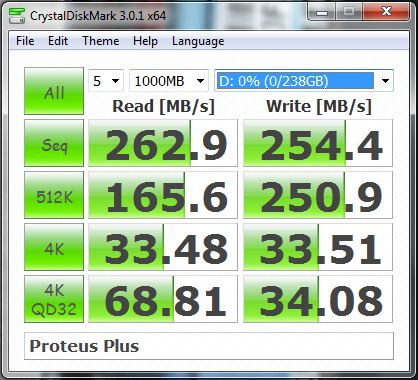CRYSTAL DISK BENCHMARK VER. 3.0.1 X64
Crystal Disk Benchmark is used to measure read and write performance through sampling of 0 Fill/1 Fill or random data which is, for the most part, incompressible. Many new SandForce Driven SSD owners who cant wait to test the performance of their SSD often grab this program and run a quick test, not realizing that they are testing with incompressible data rather than compressible data used in testing by manufacturers.
CrystalDiskMark shows the nearly unmistakable signature of an Indilinx drive. 4K QD1 reads are strong, with some scaling at higher queue depths. 4K writes don’t scale, even in newer FTL implementations with the Indilinx. That’s probably not an issue with the intended market for the TCS. Remember, according to Intel, the difference between the fastest and slowest SSDs is quite small compared to the difference between solid state and mechanical storage. Besides, the typical military/industrial workload is purported to be exceedingly light, lighter than an even a glorified typewriter. Some systems won’t even have native command queueing anyway, so higher QD performance would be under utilized.
Up until recently, AS SSD was the only benchmark created specifically for SSD testing and it tests through use of incompressible data which shows us the worse case performance scenario in SSD transfer speeds (when using LSI SandForce-powered SSDs). Many enthusiasts prefer benchmarking with AS SSD for their needs.
AS SSD backs up CDM’s results. AS SSDs access time is based on 512 byte accesses, so it’s not the end-all of metrics.
ANVIL STORAGE UTILITIES PROFESSIONAL
Over the last little while, we have been assisting with beta testing new benchmark software called Anvil Storage Utilities which is an absolutely amazing SSD benchmarking utility. Not only does it have a preset SSD benchmark, but it also has endurance testing, threaded I/O read, write, and mixed tests, all of which are very simple to understand and utilize in our benchmark testing.
Anvil’s excellent storage utility shows throughput, IOPS, and response time. The 4K response times are pretty low. Random performance isn’t the strongest, but is still competitive with many SATA II drives. Again, better random performance would most likely be lost on many industrial applications, situations where writes are predominantly sequential in nature.
 The SSD Review The Worlds Dedicated SSD Education and Review Resource |
The SSD Review The Worlds Dedicated SSD Education and Review Resource | 


Interesting. I’m curious as to why these ‘military’ units aren’t moistureproofed and dustproofed. There’s a gap at the SATA connector that would let in either.
Well, our engineering sample was stripped down to make it easier on us. There are a variety of options to make the drive moisture and dust proof, but it would make the drive difficult to take apart and photograph.
TSDEP25S256AINN TCS 200PCS keen to look for this part, who can help for?
my email: cindy@worldboomelec.com
TCS offers several options to improve resistance to moisture and dust. We offer conformal coating of the PCB with either silicone, urethane or Parylene coating. We also offer a sillicone gel fill of the entire SSD, which makes the unit waterproof. We often demonstrate such a drive sitting in a fish tank at tradeshows. The gaps you note around the connector are filled with RTV before the “tub” is filled with the gel.
The gel is not removable, so as Christopher notes it would have interfered with their abillity to review the drive.
If the Proteus Plus had been fully optioned out, I wouldn’t have been able to get the drive apart without an anvil, crowbar, blowtorch, and probably a shotgun.
Um, “as it’s SATA II interface “. It’s = it is. Please take the time to get basic apostrophe usage right. No matter how thorough your review might be, if you get basic English like this wrong, it makes me wonder what else you overlooked.
Indilinx eh? Is that the Barefoot 3 or something more ominous. lol